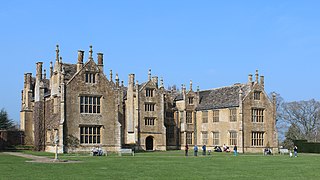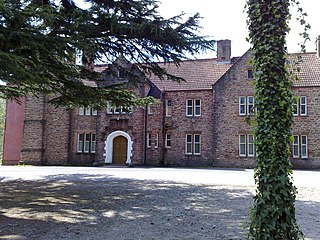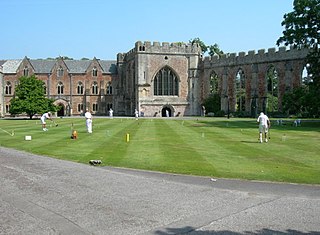
Turweston is a village and civil parish in north-west Buckinghamshire, England. The village is beside the River Great Ouse, which bounds the parish to the north, west and south. Turweston is the most northwesterly parish in Buckinghamshire: the Ouse here forms the county boundary with Northamptonshire to the north and west and Oxfordshire to the south. Across the river, the Northamptonshire market town of Brackley is just west of Turweston, with the town centre about 1 mile (1.6 km) west of the village. The parish has an area of 1,295 acres (524 ha) and had a population of 211 at the 2011 Census.

Great Chalfield Manor is an English country house at Great Chalfield, about 2.5 miles (4 km) northeast of the town of Bradford on Avon in the west of the county of Wiltshire.

The Botallack Mine is a former mine in Botallack in the west of Cornwall, UK. Since 2006 it has been part of the UNESCO World Heritage Site – Cornwall and West Devon Mining Landscape. The mine is within the Aire Point to Carrick Du Site of Special Scientific Interest (SSSI) and the South West Coast Path passes along the cliff.

Shilton is a village and civil parish about 1+1⁄2 miles (2.4 km) northwest of Carterton, Oxfordshire. The 2011 Census recorded the parish's population as 626.

Barrington Court is a Tudor manor house begun around 1538 and completed in the late 1550s, with a vernacular stable court (1675), situated in Barrington, near Ilminster, Somerset, England.

Dyrham Park is a baroque English country house in an ancient deer park near the village of Dyrham in South Gloucestershire, England. The house, with the attached orangery and stable block, is a Grade I listed building, while the park is Grade II* listed on the National Register of Historic Parks and Gardens.

Shiphay Manor is a Manor house in Torquay, Devon, England. Originally a monastic grange for nearby Torre Abbey, the current house was built in 1884 of red sandstone rubble. Adjacent is a ruined barn which has been designated a Grade II listed building. The house has been used as a hotel, a riding school, night club and then school building.

Longworth is a village and civil parish in the Vale of White Horse, England. Historically within the north-west projection of Berkshire, boundary changes transferred it to Oxfordshire in 1974. The village is between Faringdon, 7 miles (11 km) to the west, and Oxford, 9 miles (14 km) to the northeast. The 2021 Census recorded the parish's population as 543.
The Headstone Museum, also known as the Harrow Museum, is the local history museum for the London Borough of Harrow in England.

The Bishop's Palace is the residence of the bishop of Bath and Wells in Wells, Somerset, England. The palace is adjacent to Wells Cathedral and has been the residence of the bishops since the early thirteenth century. It has been designated a grade I listed building.

Stoke sub Hamdon Priory is a complex of buildings and ruins which initially formed a 14th-century college for the chantry chapel of St Nicholas, and later was the site of a farm in Stoke-sub-Hamdon, Somerset, England. The only building remaining from the college is a great hall and attached dwelling, dating from the late 15th century. The hall is designated by English Heritage as a Grade I listed building, while the outbuildings and gateway are Grade II listed. The whole site has been scheduled as an ancient monument. A number of the farm buildings are in poor condition, and have been added to the Heritage at Risk Register.

Wigborough Manor House is a manor house in South Petherton, Somerset, England. It was partly built in 1585, although it was never completed to the original designs and was subsequently modified. It has been designated as a Grade I listed building.

Caerhays Castle or Carhayes Castle is a semi-castellated country house built in 1808, 0.5 mi (0.80 km) south of the village centre, St Michael Caerhays, Cornwall, England. It overlooks Porthluney Cove on the English Channel. The garden has a large collection of magnolias.

Botallack is a village in west Cornwall, England, United Kingdom. It lies along the B3306 road which connects St Ives in the east to the A30 road, near Land's End. The village is included in the St Just in Penwith division on Cornwall Council. The original 1970s BBC television series Poldark was filmed partly in Botallack, using Manor Farm as Nampara. The Manor House, part of the Tregothnan estate, is a Grade II* listed building, dating from the 17th century.

Winterborne Clenston is a small village and civil parish in Dorset, England, around 3+1⁄2 miles southwest of Blandford Forum. In 2013 the civil parish had an estimated population of 40.

Merthen Manor is a 16th-century manor house in west Cornwall, England, UK. For most of its history it has been in the ownership of the prominent Cornish family, the Vyvyan family. The house is set in over 100 acres (40 ha) of woodland which, along with the shoreline of the Helford River, is designated as Merthen Woods Site of Special Scientific Interest (SSSI).

Harmondsworth Great Barn is a medieval barn on the former Manor Farm in the village of Harmondsworth, in the London Borough of Hillingdon, England. It is north-west of fields and the A4 next to Heathrow Airport. Built in the early 15th century by Winchester College, it is the largest timber-framed building in England and is regarded as an outstanding example of medieval carpentry. It was described by the English poet John Betjeman as the "Cathedral of Middlesex". A similar though smaller barn is part of the Manor Farm complex in Ruislip.

Poldark is a British historical drama television series created and written by Debbie Horsfield and based on the novel series of the same name by Winston Graham. It aired on BBC One for five series from 8 March 2015 – 26 August 2019, adapting the first seven of the twelve novels in the series, which were previously adapted by the 1975–1977 BBC television series. Set between 1781 and 1801, it stars Aidan Turner as Ross Poldark, a British Army veteran of the American Revolutionary War, who returns to his home in Cornwall to find that his father has died, leaving his estate in ruins. The series follows his efforts to rebuild his fortune with the aid of his maid-turned-wife Demelza and his relationships with his cousin Elizabeth Poldark and rival George Warleggan.

Godalming Friends Meeting House is a Friends meeting house in the ancient town of Godalming in the English county of Surrey. One of many Nonconformist places of worship in the town, it dates from 1748 but houses a congregation whose roots go back nearly a century earlier. Decline set in during the 19th century and the meeting house passed out of Quaker use for nearly 60 years, but in 1926 the cause was reactivated and since then an unbroken history of Quaker worship has been maintained. Many improvements were carried out in the 20th century to the simple brick-built meeting house, which is Grade II-listed in view of its architectural and historical importance.

Treguddick Manor is a Grade II* manor house and 18-acre (7.3 ha) estate in the parish of South Petherwin, Cornwall, England, to the southwest of Launceston. It is situated just off the A30 road between Polyphant and Kennard's House, near the River Inny.



















